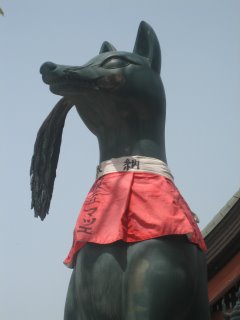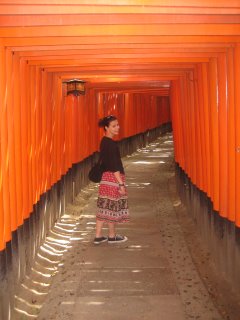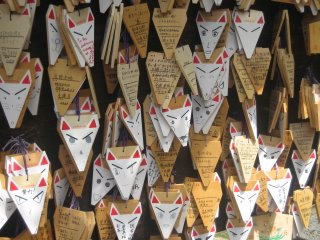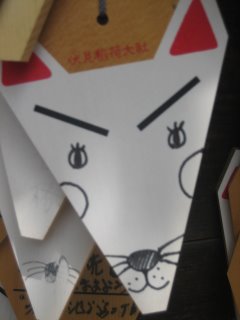 Fushimi, a sake production center just south of Kyoto, hosts the most famous and important of the roughly 40,000 Inari shrines in this country. Inari is the Shinto god of rice and sake, two central and essential commodities both in the culture and history of trade and life in Japan. As such, with the rise of industry and the diminishing importance of agriculture, the role of Inari shrines has grown to represent success and prosperity in business.
Fushimi, a sake production center just south of Kyoto, hosts the most famous and important of the roughly 40,000 Inari shrines in this country. Inari is the Shinto god of rice and sake, two central and essential commodities both in the culture and history of trade and life in Japan. As such, with the rise of industry and the diminishing importance of agriculture, the role of Inari shrines has grown to represent success and prosperity in business.

 Characterizing the site are numerous statues of foxes, messengers of Inari, and guardians of the shrine. A pair of stone fox statues stand on guard at the entry to each of the site's shrines and sub-shrines. Inari's foxes are said to be helpful, but others are said to be dangerous and bewitch people, sometimes even in the guise of beautiful woman. Foxes are also believed to be capable of possessing humans, entering them under their fingernails. A key often seen in the mouth of a fox statue is for the rice granary.
Characterizing the site are numerous statues of foxes, messengers of Inari, and guardians of the shrine. A pair of stone fox statues stand on guard at the entry to each of the site's shrines and sub-shrines. Inari's foxes are said to be helpful, but others are said to be dangerous and bewitch people, sometimes even in the guise of beautiful woman. Foxes are also believed to be capable of possessing humans, entering them under their fingernails. A key often seen in the mouth of a fox statue is for the rice granary.
 The shrine complex also has four kilometers of paths and trails winding up through woodlands to the top of the mountainside where a good view of Kyoto can be appreciated. Walking through these trails can take between two to three hours.
The shrine complex also has four kilometers of paths and trails winding up through woodlands to the top of the mountainside where a good view of Kyoto can be appreciated. Walking through these trails can take between two to three hours.


 Keeping in character with the shrine, kitsune udon ('fox udon'), a noodle soup topped with pieces of aburaage (fried tofu), a favorite food of foxes, is served at small restaurants along the hiking trail as is Inari sushi, fried tofu wrapped around sweetened rice, which also gets its name from this place. A slightly different local delicacy available here is barbequed sparrow.
Keeping in character with the shrine, kitsune udon ('fox udon'), a noodle soup topped with pieces of aburaage (fried tofu), a favorite food of foxes, is served at small restaurants along the hiking trail as is Inari sushi, fried tofu wrapped around sweetened rice, which also gets its name from this place. A slightly different local delicacy available here is barbequed sparrow.











0 件のコメント:
コメントを投稿